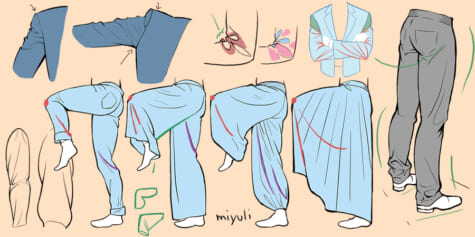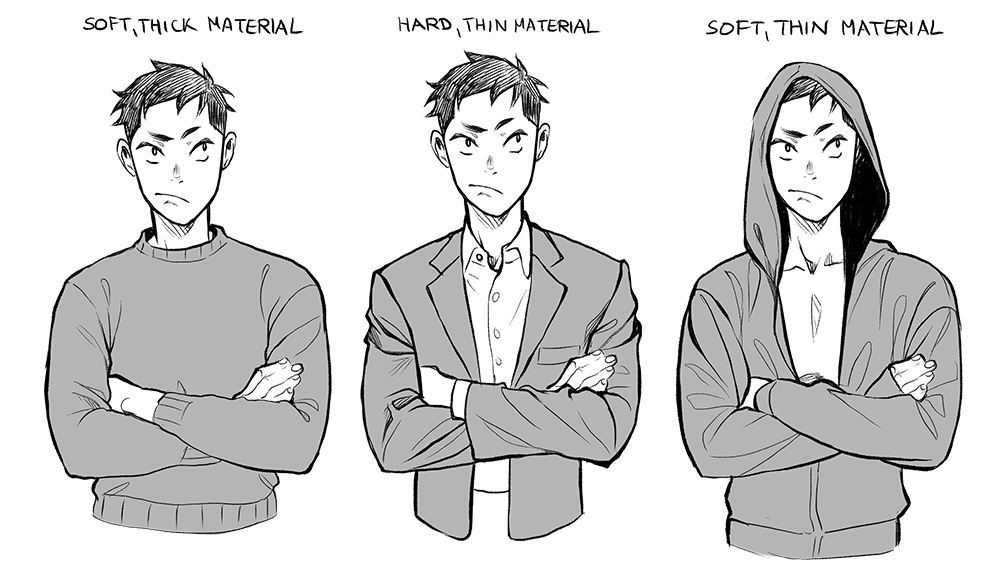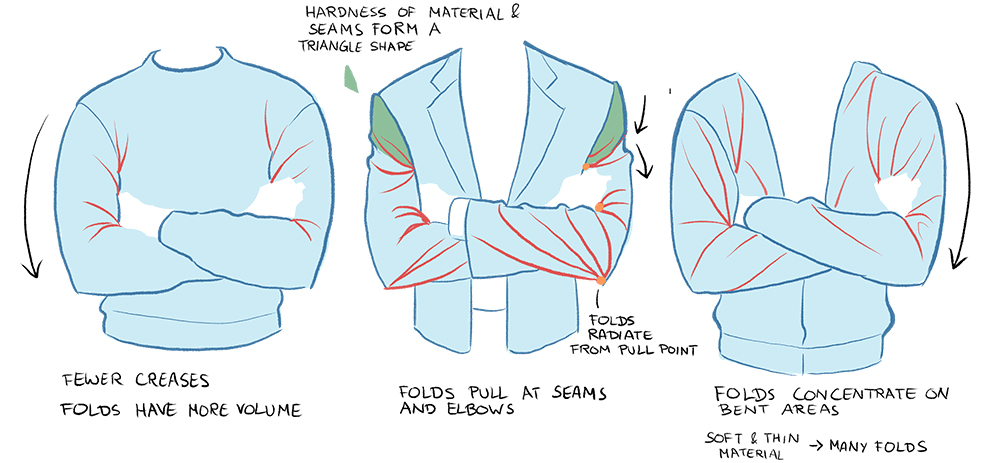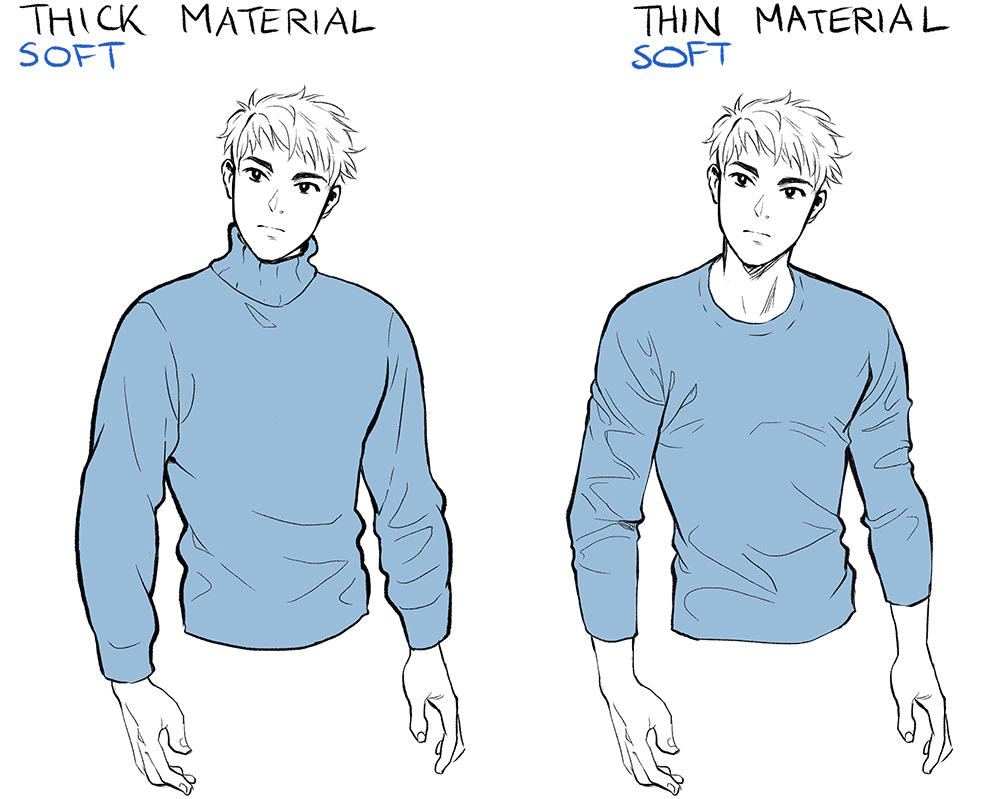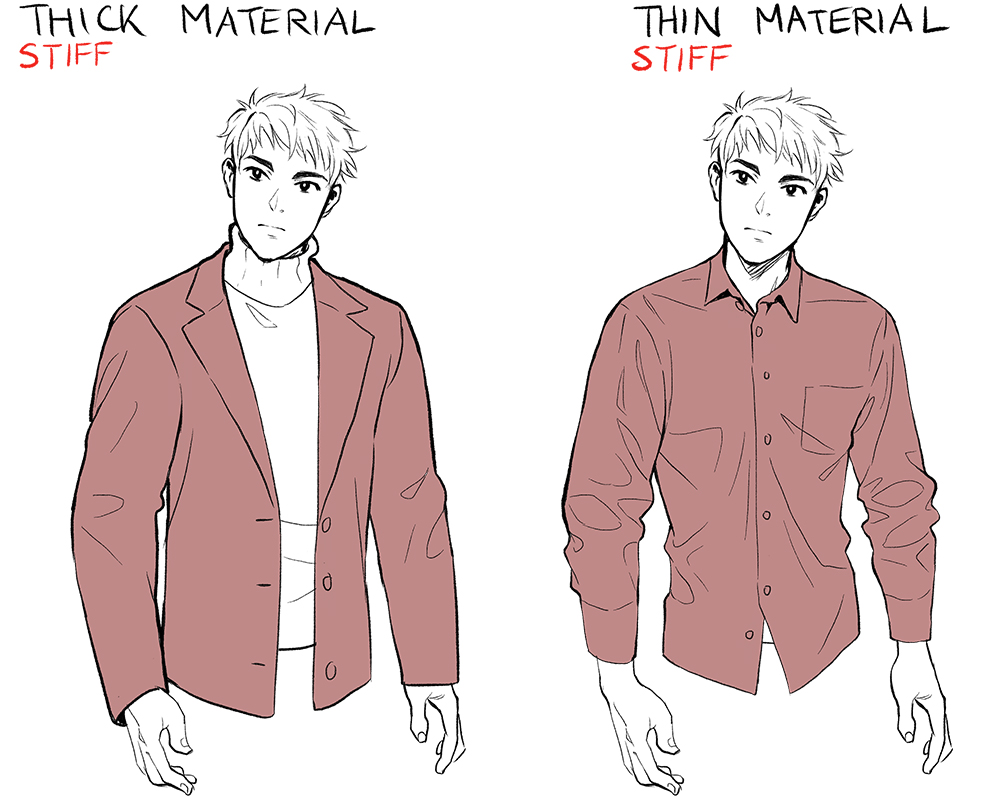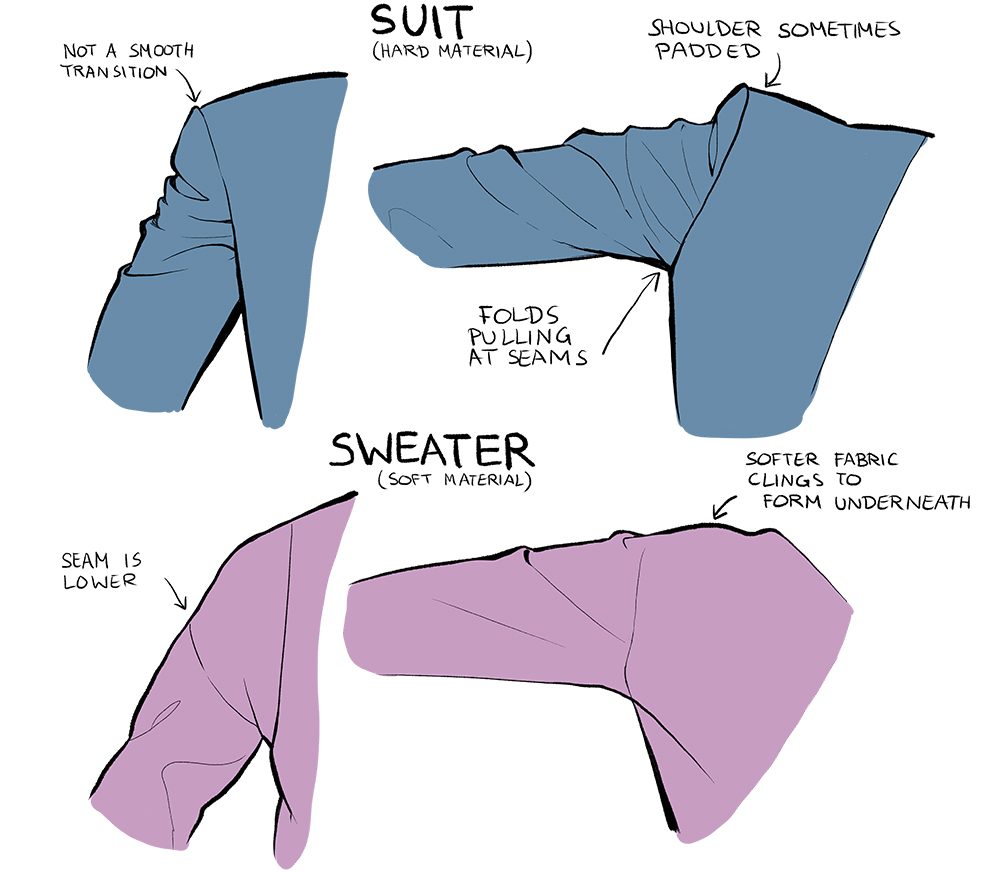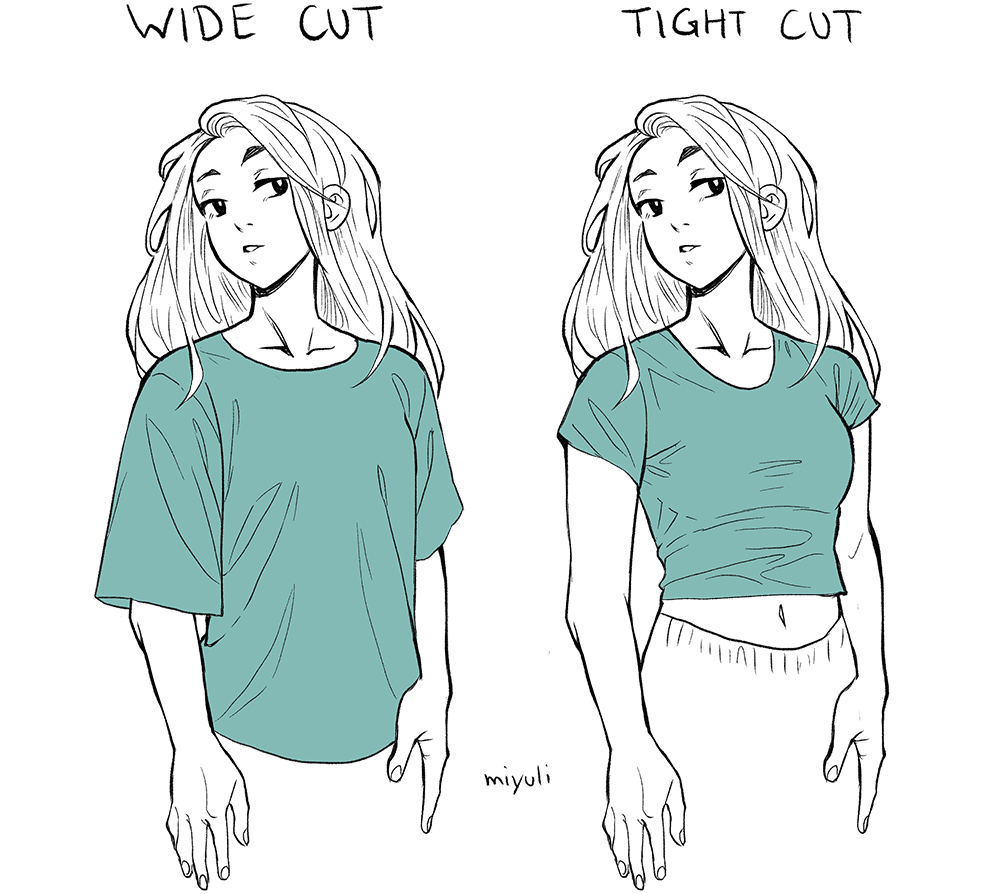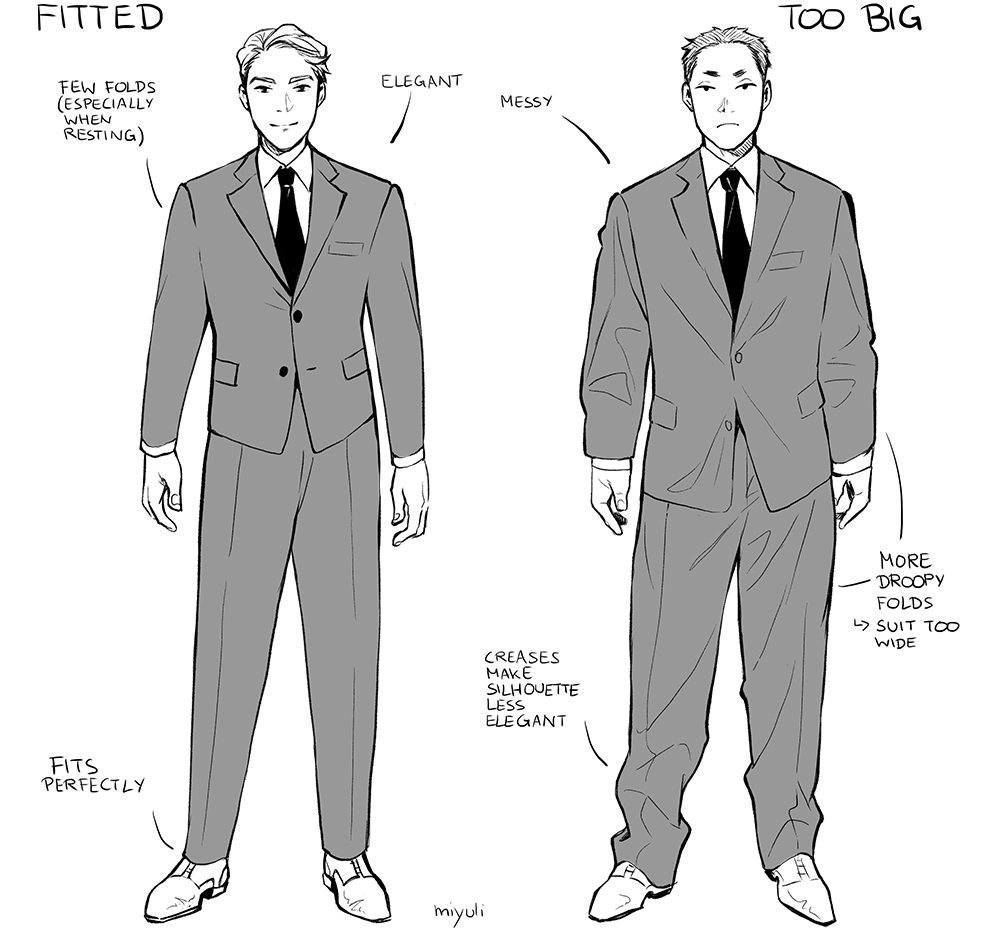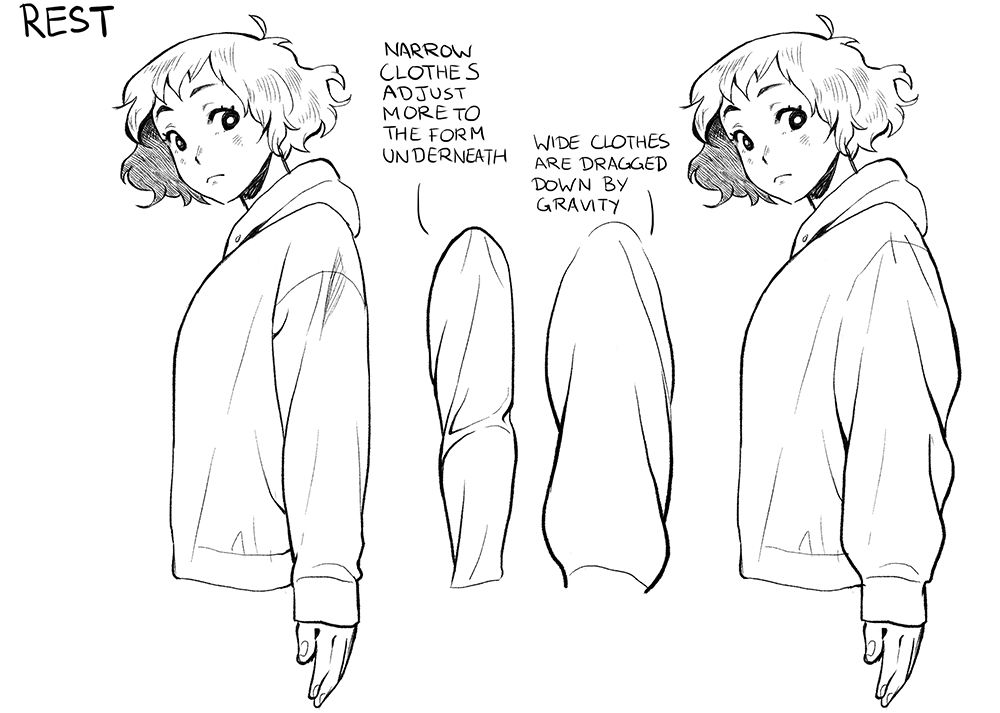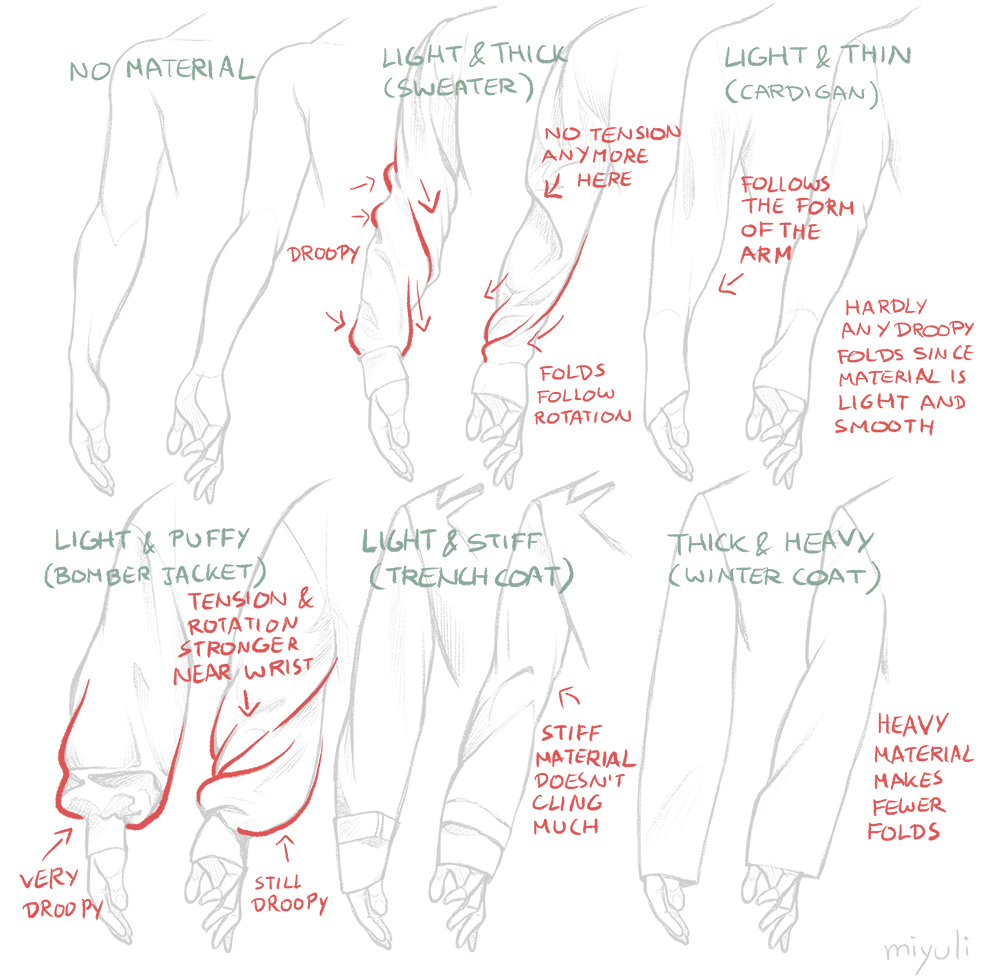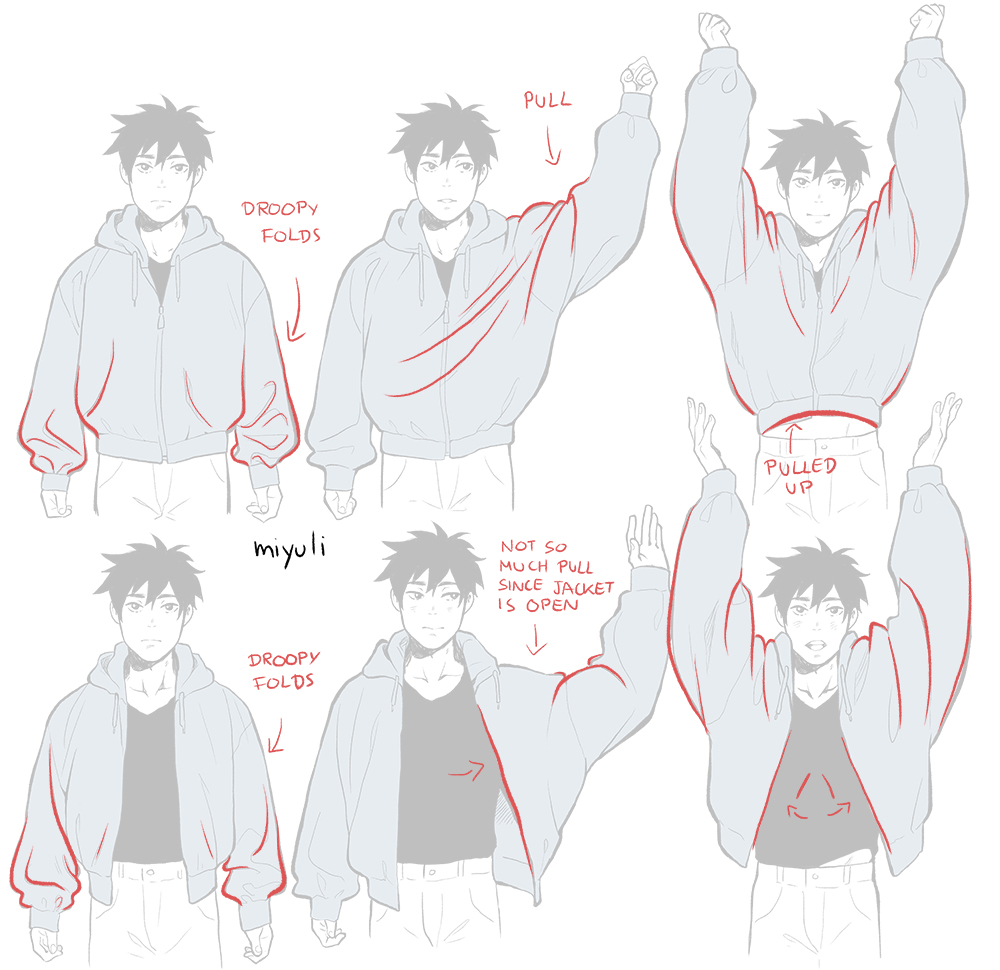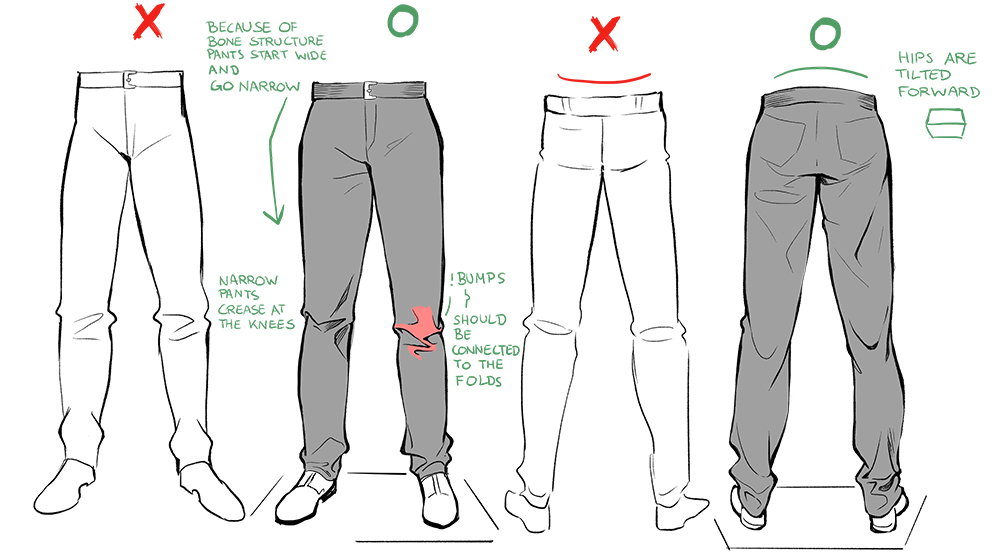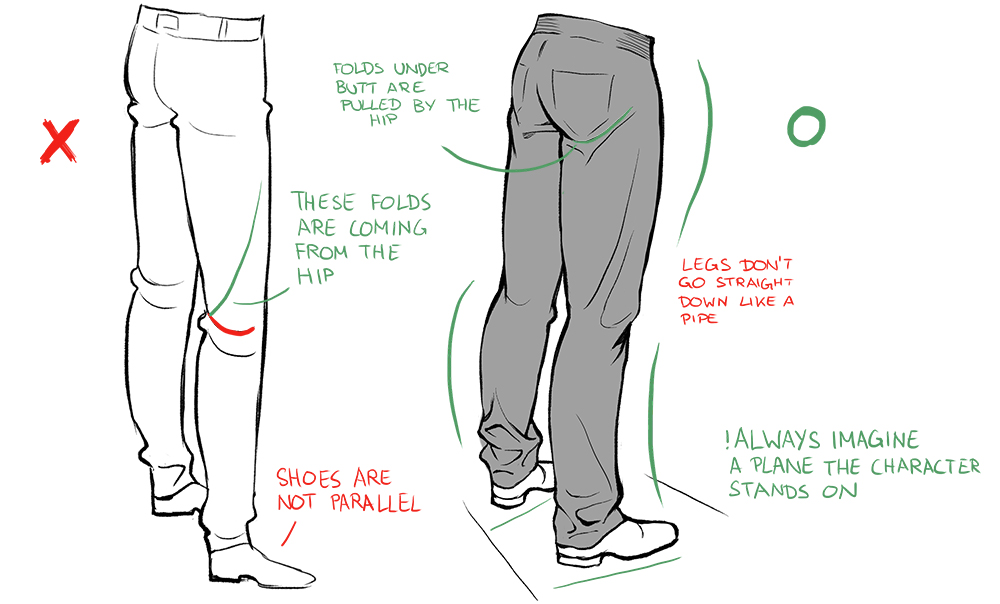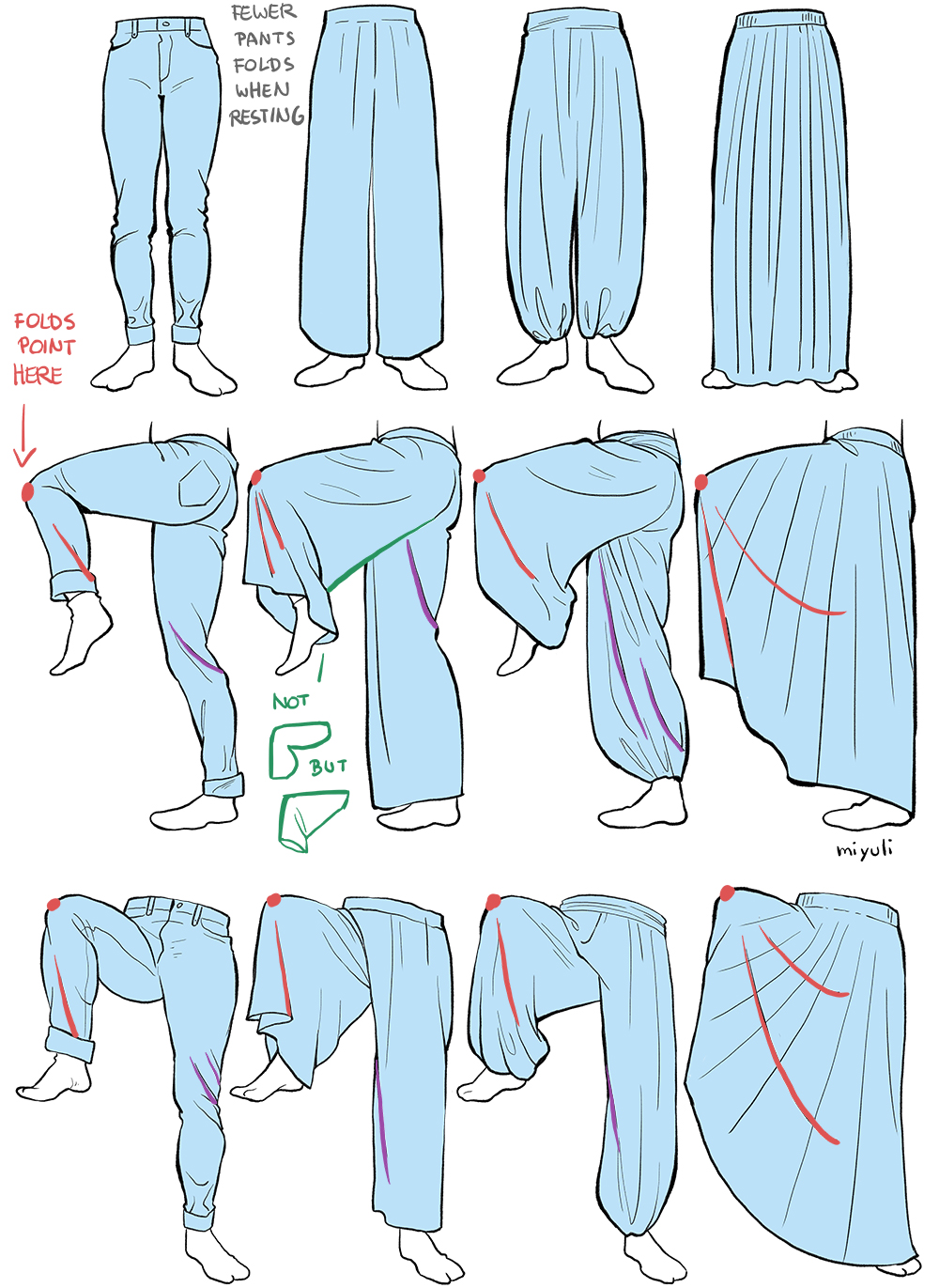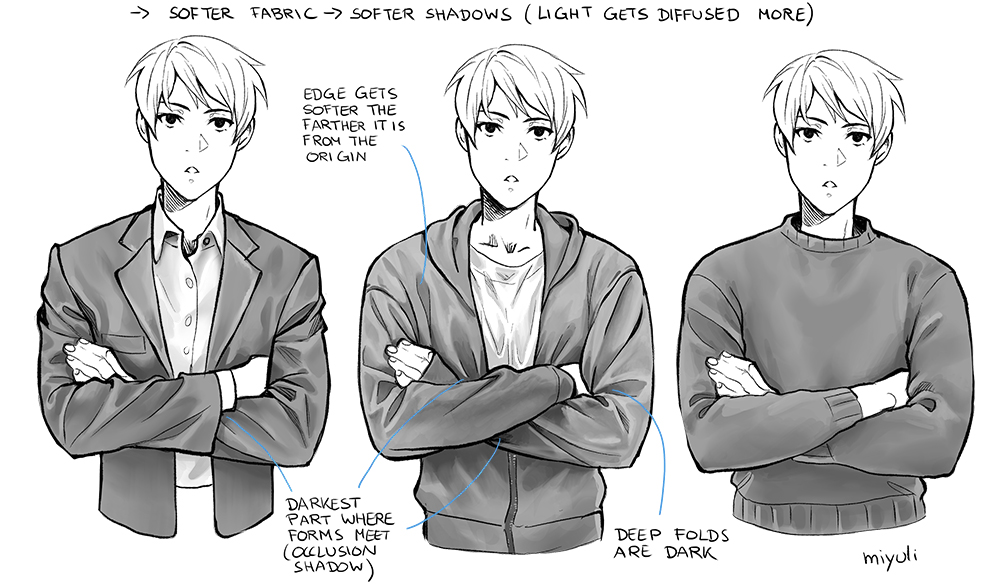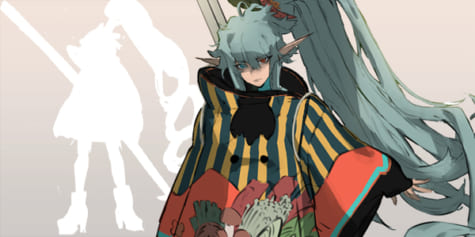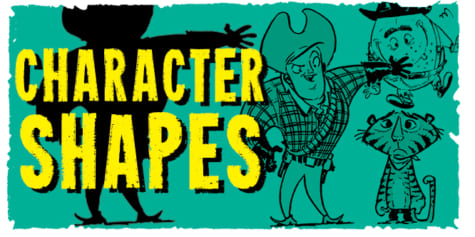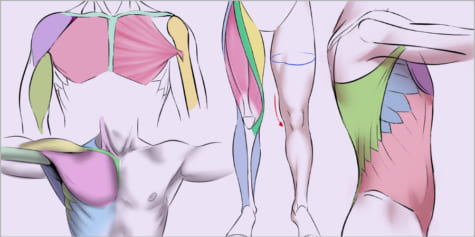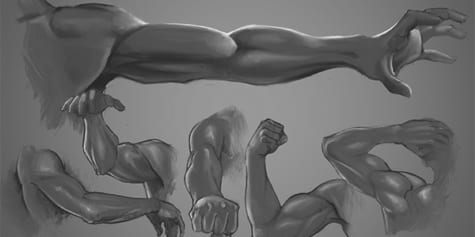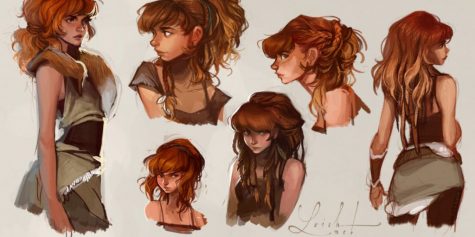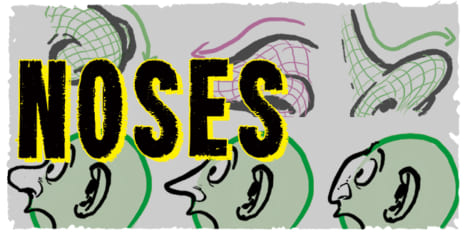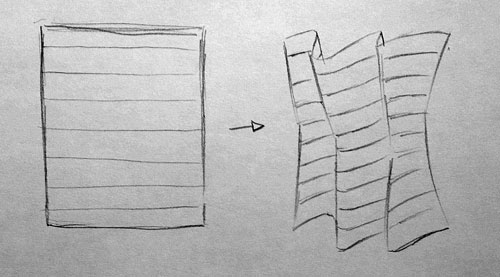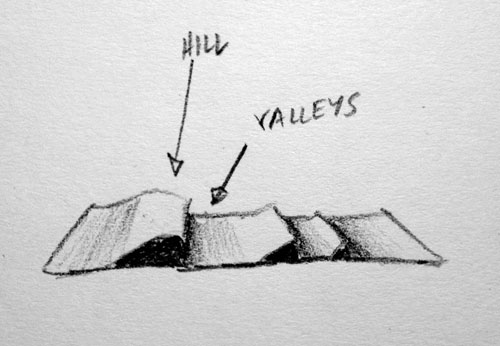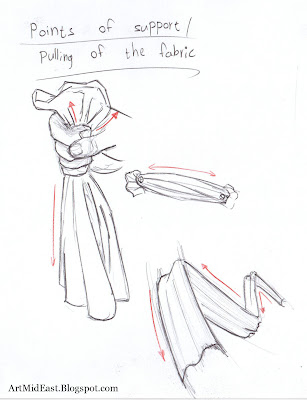How to draw wet clothes
How to draw wet clothes
Essential Tips for Drawing Drapery and Folds
Fabric and folds can take all sorts of forms depending on the softness of the material and the shape of the body. This illustrated tutorial by comic artist miyuli covers basic concepts and approaches for drawing fabrics of all kinds.
Folds depend on the form they fall on. They are not universal. There are many different types and factors that influence them.
There is no single rule on how to draw folds—The best way to understand drapery is to do as many studies of folds as you can. The more realistic you want to draw and paint folds, the more references you will need. Understanding some common principles will make it possible to draw them convincingly in a more stylized way.
I’ve collected some pointers and commonalities here that I’ve come across so far.
Materials
It is very important to consider the materials that you draw when dealing with folds. They all have their very own characteristics that help to decide where to put the appropriate folds. Their texture dictates how diffused the shadows are.
Thicker material has wider folds that are usually less visible.
Hard materials are usually pulled more at the bending area or at the seams.
Soft and thin material produces the most folds, especially around the bending areas.
The amount of folds also depends on how heavy the fabric is and what kind of material it is made of. When drawing fabric it is a good idea to consider how thick/thin, hard/soft, heavy/light and smooth/textured the material is first.
Heavy fabric causes folds of a different volume and different width. It is also more idle and shows fewer folds even when moving.
All clothes have their own arrangement of parts, which heavily influences the formation of folds.
It’s good to familiarise yourself with common placements of seams. You don’t need to draw them all, but it is better to have a good fundamental knowledge of the construction.
Folds tend to pull at prominent seams, especially on clothes like suits where the transition between seams is quite noticeable at the shoulder.
Sweaters usually have their arm seams much lower and the folds don’t pull at them as much.
Clothes with a wide cut show different folds than clothes with a narrow cut. A tight cut follows the form of the body and wraps around it. Wide clothes show a lot of droopy folds that go from the pulling point towards the ground.
Clothes are often designed with folds or lack thereof in mind.
Fitted material is designed to look elegant with as few folds as possible. When clothes are too tight or too loose there are more folds that give a less elegant appearance of the clothing, especially when looking at the silhouette.
Worn-out fabric tends to crease more than new or well-maintained fabrics.
Note: When drawing clothes and folds, it can help to consider what material fits the character’s personality first.
External influences
Folds can be heavily affected by wind or water.
Wet cloth acts differently from dry cloth. It tends to stick more to the form underneath. The water makes the light material a lot heavier, so it does not move as easily anymore. Thin fabric becomes see-through.
Movement
When the body is resting the fabric is usually dragged down by gravity. More prominent droopy folds appear the wider and lighter the fabric is.
When bent the fabric is pressed together and creates hollow shapes that vary in size.
There are more bumps with more narrow material. Wide material tends to squish together with fewer folds.
The material adapts to the forms’ movement. Folds usually follow the twist. It can be very helpful to emphasize the movements.
Note that the lighter and thinner material in the example above shows fewer folds since the arm is still mostly resting.
The arms heavily dictate the pulling areas where folds emerge.
Opening a jacket absorbs some of the pulling when the arms are raised.
Pants
The fabric of the pants is supported at the waistline.
Pants start wider and narrow down to the knees because they adjust to the bone structure of the legs.
With narrow pants, creases are usually visible at the knees.
When drawing bumps in the fabric it’s good to show their origin and volume. It does make a visual difference when you can imagine the folds in a 3-dimensional space.
From the back, you can see folds forming under the butt region that go up to the hip.
The folds at the knees are also visibly pulled by the hips from the back view.
In general, when the body is just standing and resting, there are less dynamic folds.
When a leg is lifted, the knee becomes the strongest pulling point.
Be careful of the forms that the pant legs create when the leg moves.
Shadows and Highlights
Depending on the thickness of the material the shadows around the folds appear slightly different.
When shading folds, it’s good to use a combination of soft and hard edges.
When painting pay attention to how smooth and soft the material is. The smoother it is, the more it reflects light and has a brighter highlight. Rougher and more textured materials diffuse light.
The darkest area is usually where forms are pressed together and an occlusion shadow appears. This also applies to very deep creases where light does not reach.
Here are some quick tips that I noticed while shading materials.
The shading, like the width of the folds, varies between soft edges or highlights depending on the material, so it’s good to familiarise yourself with as many materials as possible to build up a rich visual library.
Miyuli is a freelance illustrator and comic artist.
Similar articles
Learn to Draw Croquis Sketches
Bring Energy and Life to Your Poses!
How to Design Characters with Bold Fashion and Strong Silhou…
Designing characters with 7 basic shapes
Muscles of the Human Body
How to Draw an Arm
Extracting Scanned Line Art for Digital Coloring
Exclusive Interview: Lois Van Baarle (Loish)
Gothic Stylization using the Fundamentals of Illustration
How to think: Drawing Noses
Top Articles in Category
Essential Tips for Drawing Drapery and Folds
How to draw and color anime hair
Guide to Creating Color Schemes
Bring Energy and Life to Your Poses!
Easy Tips for Drawing Eyes
Anime-Style Skin Coloring Tutorial
How to Draw Hair
How to Draw Anime Eyes
How to Create Pixel Art
Color Theory for Digital Artists
Muscles of the Human Body
Natural-style Painting Workflow for Character Illustrations
Extracting Scanned Line Art for Digital Coloring
Drawing mouths and lips
How to Design Fantastical Dragons with a Touch of Realism
Grayscale to Color: Digital Character Painting
How to Draw Expressive Faces
Easy tips to paint light and shadow
How to Design Characters with Bold Fashion and Strong Silhou…
How to draw a frilly dress with a full skirt and puffy sleev…
How to Draw an Arm
How to Make Appealing Original Characters
Tips for digital outlining for Anime Art!
Designing characters with 7 basic shapes
How to Draw a Nose
Recommended Articles
Exclusive Interview: Lois Van Baarle (Loish)
Top Drawing Apps and Software in 2022 (Free & Paid)
ArtStation Marketplace Success Story: Le Vuong
Five Tips for Getting Noticed Online
Simply Well Drawn: Part 1
How to Make Appealing Original Characters
How to Make Video Tutorials
Sculpting Forms, Using Value, and Brush Introductions
Must-Know Tips to Improve Your Tablet Drawing Experience
Easy Tips for Drawing Eyes
Learn to Draw Croquis Sketches
Becoming a Concept Artist for a Hollywood Film
Bring Energy and Life to Your Poses!
3 Reasons to Use Digital Art Software
Extracting Scanned Line Art for Digital Coloring
Things You Need to Know to Become a Game Illustrator
Easy Steps to Creating Chibi Characters
Keyboard Shortcut Guide for Artists
Featured Pro Portfolio: Phil Saunders
Ultimate Guide to Blending Modes
Learn the basics of digital art, from the tools you need to the steps of creating digital artwork.
Read art tutorials and interviews with concepts artists for films, games, and animation.
Learn techniques for creating expressive and fun character art with these tutorials.
Whether you’re creating manga, comics, or webtoons, here you’ll find the best techniques to create your story!
How to Draw Clothing
JOIN THE VIRTUAL INSTRUCTOR
Get ALL of our courses, ebooks, live lessons, critiques, lesson plans and more today.
Folds in clothing can create a variety of values, lines, and shapes. All of this complexity can make it seem difficult to draw clothing. It’s easy to become overwhelmed with all of this information and become intimidated by drawing clothing. However, we can make the task a little easier if we consider a few things.
Understanding Folds in Clothing
Before I discuss the basics of understanding folds in clothing, I want to point out that there is no substitute to «good ole» fashioned observation. You can draw anything if you look at it and understand what you are seeing. Remember, drawing is mostly about observation. Learn to recognize values, lines, shapes, and textures and you can create the illusion of forms, space, and light.
So, what about those folds?
Let’s first consider a flat piece of fabric. Consider the cross contour lines that exist on the surface of the flat piece of fabric. These lines are theoretical lines and are invisible, but they help use understand the form of the flat fabric.
Now, consider the same piece of fabric folded. Notice what happens with the cross contour lines.
Pay attention here to what happens to those cross contour lines if the fabric was cupped together. Notice how mapping out the cross contour lines helps us understand the form of the fabric.
Drawing is about observation, but also about understanding what we are seeing.
Now consider the fabric like a series of «hills and valleys». Doing this will help us understand how to handle the values, which is important in creating the illusion of light. Where the fabric rises (hill), the value should be lighter. Conversely, where the fabric recedes (valley), the value should be darker.
Understanding the cross contours and how to handle the values will go a long way in creating the illusion of folds in clothing that you’re after. Couple this with observation and you can’t go wrong.
How to Draw Folds in Clothing and Fabric, a Step-by-Step Tutorial
So you want to learn to draw folds well. You want to learn to draw various types of folds. You wonder what kind of folds exist, and if they combine together to make more folds.
You are in the right place! And yes, folds do combine to create more complex arrangements of folds.
If you are someone who likes the quick answer, here is my best quick answer to how to draw folds well, summarized in just one sentence:
To draw folds in clothing or fabric, you must (1) provide an accurate (and often swiftly simplified) depiction of folds for the viewer, AND (2) through the editorial process, depict them in an arrangement more pleasant to the eye than mere reality.
Drawing Folds, Table of Contents:
Drawing Folds in Fabric and Clothing, Step-by-Step
You can download the high-resolution image above, as well as other materials that go together with this tutorial by signing up for my free, once-a-month newsletter here.
Here are the steps I will be using to draw folds in these examples:
Step one: Identify the form underneath, identify tension points, and types of folds, and all other areas of force applied to the folds – (all of this in detail below!). After this identification process, draw general shape and account for main folds
From this first step, I used a simple rendering technique of blocking in the local color, then shadows and then highlights. identify local color and paint it in. Because I wanted to give a three-dimensional feeling to the folds, I decided to shade them in using this type of rendering.
Step two: identify local color and paint it in
Step three: paint in shadows
Step four: paint in highlights
Drawing Folds in Clothing, Step-by-Step 1:
This first step – the line-art drawing, the underdrawing of the fabric/clothing and folds you plan to draw is the most important in this process. Here we need to think about how the underlying form impacts the shape of the clothing and folds.
We also need to sketch out placement of the main folds, so they are easy to return to later when you ready to render them.
I added a simple local color to this drawing.
Continuing to observe from step 1, I rendered out the shadows, trying my best to make sure they make sense for the form underneath the clothing.
We will cover each individual type of fold in a bit in this tutorial! For now, I want to go over some examples to give you an idea of the process.
Here, the highlights are added to make folds stand out. The focus is on planes that are hit by most light.
Drawing Folds in Clothing, Step-by-Step 2
Okay, let’s quickly go through another drawing of folds on clothing one more time, before we get into different types of folds. If you want to skip to the fold types, click here!
(Note, below you will also find a third step-by-step overview, as well as videos of process for all of these renditions.)

When creating the initial drawing, start to think about tension points, and how the fabric is pushed or pulled by various underlying forms. Tension points are also called points of support and are origin points for tension in the fabric. For example, at the elbow of the left arm (on our right), there are folds caused by compression of fabric, since the elbow is bent and the clothing is somewhat baggy on the frame.
Here, I added local color to the drawing.
In this step, I added shadows. Again, carefully thinking about which planes are in shadow and which planes are still seen light.
Finally, I added some highlights to the hoodie. You can see light hitting the surface from the top.
Examples of Different Types of Folds
I found a good listing of the types of folds in Bridgman’s art book “A Complete Guide to Drawing from Life”. Bridgman’s book is an excellent source and one I highly recommend, it is also not the easiest to understand.
I found many places online where Bridgman’s section on folds is posted without context, and did not find that too helpful.
Below, I will be adding my own comments to the best way to remember and study each fold in hopes of making things easier to learn.
If you are contemplating if you should even study different folds or not, yes study them. Just draw each one a few times, it will take a day, but it will be time well spent in the effort to improve your drawings of folds in clothing. I definitely saw improvement in my overall drawing of folds after I spent time learning each type of fold.
Once you know them, it almost becomes a game to identify them on your reference, also forcing you to break down a complex folding fabric into simple parts, which in-turn makes the entire arrangement easier to draw.
It is important to note that different types of folds can, and often do, mix with one another. Therefore, the study of different types of folds is a departure point and not the destination to drawing folds in clothing and fabric.
Look at the different types and try to spot them in real life and picture reference as a start.
Diaper (U shape) fold
The diaper fold is the U shape fold. There are two points of tension, one on each side holding the fold up, it sags in the middle creating a U shape. It is the fold found in a hood as it descends down the back.
To draw the diaper fold well, follow how the sagging volume moves down from each point of tension. As Bridgman notes “follow to where the two sagging opposing forces meet and study carefully how they interlock”. Your ability to properly document this meeting of opposing forces in the middle of the U in the diaper fold will directly reflect how well you can draw this fold.
Zigzag fold
When a tubular fold is bent, the inner side buckles onto itself as the excess cloth is revealed from compression, creating a pattern that often replicates a zigzag.
The best way to draw this and most other folds is to analyze your reference and be sure that you understand every separate plane of the cloth, know which bents into where, before you put it down on canvas.
Otherwise, you will just be drawing lines going in different directions, without an effort to describe form, and it will not lead to a result we can call good.
Study the object enough where you can identify what happens at each crease and bend, then draw. When drawing you may choose to simplify, and only keep that which is of utmost importance to communicate what you, the artist, are seeing, and discard the rest.
Spiral (twisting) fold
Spiral folds radiate from the one point of support, and although they start out in a similar path, they fan out as they move further from the supporting point, and move further and further from being parallel.
Think about what you choose to represent on canvas. Your reference, depending on the fabric, may have twenty radiating spiral folds in an area that you choose by design not to focus on.
If you choose to focus somewhere else, this area will need less attention, therefore you’d choose to simplify and show just a few spiral folds instead of all twenty of them.
Half-lock (elbow) fold
A half-lock fold sounds confusing but it is really not. It is the fold that happens when fabric changes direction. Most prominent around bending elbows and knees, I like to call it the elbow fold.
Think of the name half-lock, the fabric folds on itself, creating a thinly shapes U in the middle, with edges of the created folds almost locking together to hide the crease out of view. Look at the example above.
Remember two things: change of direction, and elbow fold.
Pipe (cylinder) fold
Pipe or cord folds, descend down from a point of support. It is a tubular shape that radiates down. Look for these pipe-like forms in different photographs of drapery, realize what the form is actually like. Since pipe folds are essentially cylindrical in nature, they can be rendered as cylinders. Study these in the context of a complex drapery arrangement.
Drop fold
A drop fold is what happens when the drapery is suspended at a point of support and it drops down without any impediment, giving itself to the force of gravity. No other folds or forms get in the way of the drop fold.
Reading multiple materials on folds, I found that it is suggested that the drop fold has high ornamental value, and can be used to create interest in your compositions.
Of course this is true, but I believe it to be true about any folds. The point here being, that a masterful representation of folds will both (1) provide an accurate (and often swiftly simplified/focused) depiction of folds for the viewer, AND (2) through the editorial process engaged by the artist, will depict them in an arrangement more pleasant to the eye than mere reality.
Inert folds
Inert folds. Inert folds are folds that form when the drapery is thrown to lay on a surface. A fallen piece of cloth that looks still is a good description of inert folds. Think about what has to be represented in the drawing to let the viewer know that the drapery is still. A good drawing of inert fabric will lack even a hint of inertia or momentum. Think of the surface it is on, and work through all the plane changes in the design. The goal is to show to the viewer that this section of cloth is still.
Inert folds lay on a surface still, and are generally made up of various other folds.
Forces Affecting Folds: Tension Points, Underlying Form, and Gravity
Points of Tention (Points of support)
Trying to identify points of tension (points of support) in every single fold can become maddening after a while. Here are some tips to make the process easier.
Remember that points of tension are the origins of tension you see in the folds. Folds usually radiate out from points of tension.
Ask yourself, what is fabric doing at any particular surface, where is it being pulled to, is it twisting, folding on itself, or it is being stretched? AND – what information do I need to depict on canvas to convey this action, (or inaction), without more detail than absolutely necessary to accomplish that goal.
Further, note that in some situations, it may be enough to know the general direction of tension, without being precise with exactly where the point of tension is on the canvas (sometimes it can be hidden on the side of the form away from view). Yes, you should identify where the fabric is pulled or where it is pushed to, but also focus on the overall gesture of the fabric and try to depict its character.
What do you mean the fabric’s character? Well, is it tense, stretched to it’s limit, or is it lose? Are the folds many or few? Are the folds sharp, or are they forming round bellies like a thick fabric would? That sort of thing.
Underlying Form
The underlying form will stretch, and pull the fabric. Fabric will also rest on the underlying form, be it a human arm or a table or a couch. While the underlying form is always underneath the fabric, tension points can come from the outside. For example, holding up a piece of fabric by the pinch of the index finger and the thumb creates a tension point for the fabric at the point where the two fingers meet.
Many times, an underlying form will act as a tension point. The shoulder, for example, can act as tension points at each side of a diaper (u shape) fold handing around the neck and chest. At other times, the underlying form will change the direction of the fabric – when an arm is folded for example.
Gravity
Don’t forget that unless your subject is in outer space, drawing fabric folds must account for gravity. At all times fabric folds are being pulled down to the ground.
Other forces
What about a long coat hanging off a figure, and blowing in the wind? Are the folds impacted by the wind in this situation? yes, they are.
What about a figure in the same long coat spinning around fast, is the coat impacted by the forces created by the spin? Yes. Or the same figure jumping in the air? Yes.
So think through these situations. In these special cases, it is easiest to recreate what you are trying to draw, and to take reference pictures, and study them carefully.
I’d like to mention here, that so much of how we draw in childhood has to do with looking at something and trying to replicate it on paper, or imagining something and drawing it as we see it in our head. It is a very direct input and output process.
For drawing anything complex, folds including, this approach learned in childhood is not going to work.
Instead, think more along the lines of: input – lots of thinking about what you are seeing – then output. When we draw folds, even when looking directly at reference, we need to really think about what the material is doing as it folds onto itself, bends, and covers underlying form.
This approach will always yield a better drawing than just blindly copying shapes and dark and light spots. Your drawing of folds is the expression of your understanding of the structure you are looking at.
Additional Points When Drawing Folds in Fabric and Clothing
Identifying Points of Tension in Folds for Drawing
Sometimes, instead of looking for points of tension in the folds fabric or clothing for your drawing, it helps to take the reverse approach. Look at your reference and think to yourself, what has to happen for the fabric to be stretched or pushed in the way that it is? Asking this question will lead you to the points of tension you are looking for.
Some more words on points of tension in clothing. Do not forget about motion when drawing folds. If you are drawing a dynamic figure, remember to question the path of motion in the context of points of tension.
For example, with arms being raised up, when wearing a dress shirt, clear points of tension are created at the armpit and the elbow. Try it and look in the mirror, you should see folds radiate and fan out from those areas. This means that these points can change depending on the action, and the garment itself – how loose or tight it is on the body.


Shading Folds in Clothing
Drawing folds in clothing and fabric comes down to being able to represent various forms in a convincing way. To do this, the artist must divide the drawing in the light side (the surfaces that appear lit up) and the dark side (for the surfaces in the shadow).
Be careful, do not make the light areas of the shadow side too light, and the dark areas found in the light side too dark. Generally, the darkest area in the light side of the drawing should be lighter, than the lightest area in the shadow side of a drawing. If this sounds confusing, check out my tutorial on drawing light and form here.
Video Process of Drawing Folds in Clothing
Before we get to the next process video, here is a breakdown of the drapery study you saw at the beginning of this tutorial:
Additional Step-by-Step guide on Drawing Folds
Now that we went over different types of folds and the points of tension, let’s look at one more step-by-step process for rendering fabric folds.
Create an underdrawing sketch, a roadmap to how you will depict the folding fabric in your reference.
Be sure to identify all large folds you find relevant.
Think about how the fabric wraps around the forms underneath, then compare to your sketch, did you represent this aspect of the fabric well in your initial sketch?
Here I added 1 color for mid-tones.
In this step, I break down the composition into two – the light side and the shadow side.
Here I added darker darks of the shadows, to create more depth.
In this step, I added lighter tones to where the light hits the surface.
In this final rendering, I added brighter highlight spots and fixed a few details.
I hope this guide helped you study this important topic! Masters from Da Vinci to Sargent all studied drapery to improve their art skills, and I know we can too! Good luck on your art journey!
Download Posters of Drawing Folds, and High-Res Images
20 Simple and Easy Clothes Drawings – How to Draw a Dress Step by Step
Not everyone has the artist’s talent, but to succeed in this type of creativity, it’s worth starting with step-by-step drawing lessons or trying your hand at sketching. It’s more convenient and easier to do this with a pencil, the quality of the paper is not important. Here are collected simple cool black and white and color drawings, which will be interesting and easy to draw for both children and adults.
For drawers who love to draw clothes and future fashion designers, we have put together a gallery – pictures of clothes for sketching. Such pictures will help to acquire skills in sketching clothes. Next, we suggest looking at light and beautiful drawings of clothes.
Fashionable dresses, T-shirts, pants, shorts and other important clothes are constantly used by people in the envy of the time of year. For each event, we try to find the most suitable elegant outfit to look stunning. See further beautiful pencil drawings for drawing clothes.
First of all, this is a bridge between you and the customer, because no matter what a brilliant idea eats your brain at night, they won’t understand you without a sketch until you put your “masterpiece” in front of the client.
A person who is far from the intricacies of your production will not at first be interested in where and what (what will be the fold, stitching, fit, seam processing, etc.): it will either hook at first sight or not! Then there will be a debriefing with all that it implies: “What is there and what is there?”.




The next step is the question, but what should be this very “catchy” picture? There are two areas of drawing: academics and fashion. Academic drawing will offer you a standard drawing scheme of the human body, which contains “8 goals.” This method of presentation looks very humane, proportionate, but the clothes look controversial.
Therefore, in the world, there is a whole trend of fashion drawing, and in all the best design institutions in the world, this discipline is given a huge amount of time, for example, Institution Marangoni in England. I am sure you saw these beautiful, colorful, little magazine-style illustrations of designer clothes. There are a considerable number of famous artists who paint only in this style, and how many designers!
The only moment! If you are not working for yourself, and you have cutters, fashion designers and especially a designer, then you need to be prepared to provide them with a completely different drawing or at least draw clothes in front of their eyes, along the way explaining where what and how. In this case, the clarity and maximum detail of each groove, crease, drapery, etc. are needed.




The main difficulty in drawing a figure is to imagine the bends of limbs in the imagination. To do this, you need to not only know what the balance of the body, supporting leg, etc. is, but also see all kinds of small movements of the hands, collarbone…
You need to understand where the shadow will fall when you turn the body, where the thigh bone will go when it rolls over the leg, or for example, that visually when moving, the leg located at the back will look shorter with respect to the leg located in front, while the center of gravity will shift, etc.
Moreover, anatomical drawing is a separate discipline in higher art schools, and as the granddaughter of an anatomy professor, I can assure you that this is, sorry, brain removal. I saw all these books with images of all kinds of limbs, with a pile of bones and muscles, in movements and without … brrr!
I suggest starting with this scheme so that you can see the proportions of a classic body and a fashion sketch. As for drawing movements, I can advise one effective way. Draw! Peer into the movements of the bodies in the photographs.






Thanks to experience, you will already have a memory of hands, and you can certainly draw a figure in clothes for a beautiful presentation. I always do this: I find the necessary movement on the Internet, take a sheet of paper with a pencil, sit down in front of the screen and draw. More or less like this:
The ability to draw will also come with the experience of multiple repetitions when you can easily grasp the relationship between the parts of the depicted object. In short, take a minimum of basics, like proportions, and multiply this by days and nights devoted to drawing. For drawing clothes you don’t need bodies in flight, dancing, jumping and others, so I’m sure that there will be no difficulties in the process of self-education that you could not solve yourself!





How to draw wet clothes
In this drawing lesson, you will learn how to draw clothes and folds!
The lesson will be built in a way that will allow you to build a good understanding of the basics, and to continue learning and improving on your own!
But, once you get the basics down, it becomes really simple, and my goal is to get you through the basics, so you can continue your journey by observation and self studying folds and clothing in more depth.
But enough with that, lets start drawing! We will begin with the basic types of folds.
Here I will present the basic types of folds. Some of these overlap, and some contain others within them. study the folds carefully, and create them on your own. My suggestion is to actually grab a small towel and follow my instructions. Do this, and you will understand these in no time!
 |
| Click image to enlarge |
These are the type of folds that occur when a piece of fabric is «squeezed» on the body it is on. In order to understand this, wear a long sleeved shirt or a sweater, pull your sleeves up and look at the folds created. This type of folds is also common on some types of curtains, as well as waistbands that have a rubber band inserted into them (the rubber band pulls the fabric and creates these folds).
Notice I drew a simplified, red colored version to help you understand the basics of this type of fold. That’s it for the spiral folds!
For more in depth explanation, check out my new eBook, which is The BEST, cheapest resource out there on drawing FOLDS and CLOTHES. Get your copy now and MASTER this skill-set!
Half lock folds
This fold is a brother of the zigzag and spiral folds. It occurs when a fabric changes it’s direction abruptly, causing it to layer on top of itself. This can be found in bended knees (similar to the zigzag folds, only in a different place) and arms. Again, look at the difference between thick and thin fabrics.
One of my personal favourites. This fold is really versatile, and can be found in many places. One simple way to make it, is to grab a towel with both hands, and pull them away from each other. In pipe folds, the fabric is sort of «layered», not as much as it does in the half lock folds, but just enough to create these «pipes». Also look at both examples of curtains. In the bottom right one, notice how the pattern follows the shape of the pipes.
—-
Check out my new website and subscribe for a FREE eBook! (=
LironYan.com
—-
These are all of the main types of folds. Now I would like to talk about a few other aspects that influence the way folds look like when drawn.
Thick fabric VS Thin fabric
Look at these examples. Thick fabrics usually lead to fewer, thicker folds. Thin fabrics usually lead to the creation of many thin, varied and layered folds. Also look at how the edges of the folds and fabrics make it look thick or thin.
Small VS Large quantity of fabric
The more fabric there is, the more folds are created. This is pretty intuitive, but also pay attention to the complexity of the folds. More fabric usually leads to more complex folds, and more layers and inert folds. Drawing a big piece of fabric, like a thin drapery, can actually become quite a challenge!
Points of support / Pulling of the fabric
The key here is understanding that folds are usually created in such a way that they are pointing towards (or away if you rather) the point of support, or the direction in which they are pulled. Look at the different examples to understand what I mean, and try manipulating the folds on a piece of clothing, and see how they «react».
Size of the object «wearing» the fabric
Nothing mind blowing here. Generally, the more the fabric is worn tightly on the object / body, the less folds we will see. Also, the folds that do occur will usually be smaller.
Besides drawing folds, there are many more things to learn about!
Here are but a few examples of objects and concepts to get your creative mind working.
